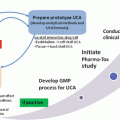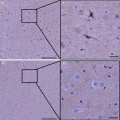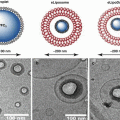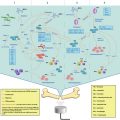Fig. 3.1
Obstruction of the acoustic beam path by the thoracic cage. As the left illustration displays, only the caudal part of the kidneys can be reached by an extracorporeal transducer from dorsal direction, without parts of the propagation path being partially obstructed by the first and second floating rib. In particular the more cranially located left kidney is often only reachable by an intercostal sonication. With respect to the liver, only lesions in segments 4b and 5 can be reached by an extracorporeal transducer from a ventral position without any obstruction by the costal cartilage or the ribs, as shown in the center illustration. Therapy in segments 1, 2, 3, 4a requires angulated sonications. These partially interfere with the costal cartilage or the sternum. HIFU therapy in segments 6 and 7 of the liver generally require an intercostal sonication through the last two false ribs (9 and 10) from a lateral position, as shown in the right illustration. Otherwise, therapy in segment 8 is obstructed by both the false ribs and the costal cartilage (Image courtesy of Dr. Mario Ries, UMC Utrecht)
Firstly, the high ultrasound absorption coefficient of the bone (Goss et al. 1979) reduces the available acoustic beam power in the focal area. Moreover, the thoracic cage acts as an aberration, decreasing the focusing quality of the ultrasonic beam (Liu et al. 2007; Bobkova et al. 2010). Due to such beam aberrations, the required temperature increase in the target area may be significantly reduced (Liu et al. 2005). This leads to either a significantly reduced volumetric ablation rate, or, if compensated for by an increased total emitted power of the transducer, to an increased risk of undesired near-field damage due to high acoustic power densities in the intercostal and/or abdominal muscle and ribs.
Secondly, the high acoustic absorption in the ribs and the cartilage can lead to local hyperthermia in the cortical bone, the bone marrow and the adjacent intercostal muscle. During energy delivery, temperature elevations directly adjacent to the ribs have been reported that were up to five times higher than the temperature in the intercostal space (Daum et al. 1999). Such high local temperature elevations can lead to adverse effects, such as skin burns and intercostal tissue necrosis, which have been frequently reported in clinical studies (Wu et al. 2004; Li et al. 2007). Jung et al. (2011) reported rib necrosis and diaphragmatic ruptures as the most frequent complications for HIFU treatments of hepatic tumors.
Several measures have been proposed to reduce or to avoid these adverse effects. In some cases, surgical removal of the part of the ribs that intersect with the acoustic propagation path has been applied to selectively perform HIFU treatment (Wu et al. 2004). However, this negates the non-invasive nature of HIFU interventions and is likely to introduce new sources of adverse effects such as scar tissue, which in turn can lead to skin-burns.
The currently most commonly proposed method to mitigate excessive rib heating and restore focal point heating is beam shaping. Ibbini et al. (1990) proposed a HIFU transducer design in form of a sparse spherical phased array. The main motivation of the use of spherical phased arrays is the combination of a geometric focus with the possibility to deflect the beam by modulating the phase of each individual transducer element. For intercostal sonications, this type of transducer design offers the additional possibility to selectively attenuate, or even deactivate, parts of the transducer surface. This has been demonstrated by McGough et al. (1996) and Botros et al. (1997) who proposed in theoretical design studies to adjust the amplitudes and phases of the voltage signals driving the individual phased array elements to limit rib exposure, while preserving the focal point intensity.
Civale and coworkers (2006) investigated the use of a linearly segmented transducer for intercostal sonications. He validated in both simulations and experiments the earlier prediction that the deactivation of edge segments leads to a significant reduction of the acoustic intensity on the ribs.
Since these early years, several refined methods to derive efficient beam shaping for intercostal sonications have been suggested. They fall into two families: Approaches that use anatomical information in conjunction with acoustic simulations to derive the aperture function, and methods that directly use the therapeutic transducer for the detection of attenuating/scattering structures.
3.2.1 Apodization Methods Based on an Anatomical Model of the Thoracic Cage Using Binarized Apodization Based on Geometric Ray-Tracing
One of the first methods relying on anatomical information was proposed by Liu and coworkers (2007). Their method is based on geometric ray-tracing using CT images of the thoracic cage. In this approach, obstructed elements of a 2D phased array are identified by testing whether the normal vector of each element intersects with parts of the thoracic cage, as shown in Fig. 3.2 on the left.
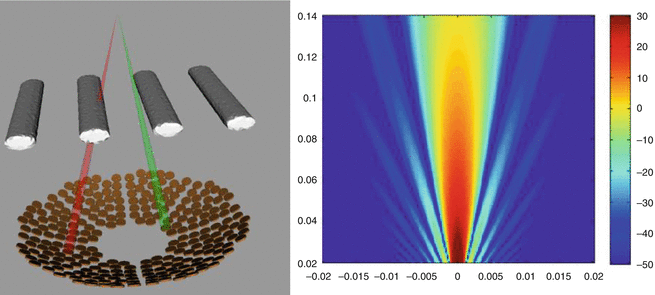

Fig. 3.2
Binarized apodization approach for the compensation of the obstruction of the ultrasonic beam path by the thoracic cage. The true acoustic emission profile of an individual cylindrical phased array element (shown in the right image) is approximated by a geometric ray in the normal direction of each element (shown on the left). Each ray is tested for intersections with scattering/attenuating anatomical structures, and obstructed elements (red) are selectively deactivated, while unobstructed elements (green) are amplified to partially compensate for the lost acoustic power (Image courtesy of Dr. Martijn de Greef, UMC Utrecht)
A subsequent selective deactivation of the obstructed elements (Fig. 3.2, red) and an amplification of unobstructed elements (Fig. 3.2, green) leads to a binarized apodization function, which can substantially reduce undesired heating of the ribs, while maintaining sufficient energy deposition at the target area. Quesson and coworkers (2010) demonstrated the effectiveness of this approach both ex-vivo and in-vivo by using anatomical data derived from MR-images. The advantage of using MR-images in the context of MR-HIFU is that the anatomical information can be obtained with the patient in therapeutic position, thus taking local deformations and shifts of the organ vs. the thoracic cage directly into account.
Furthermore, this method requires only a model of the thoracic cage with a moderate spatial resolution (<1.5 × 1.5 × 1.5 mm3), which can be obtained in a clinically relevant time frame. This approach is computationally efficient enough to be potentially feasible in a clinical workflow. The main drawback however is the coarse approximation of the true acoustic emission profile of an individual cylindrical phased array element (Fig. 3.2, right), which is in the form of a much more complex Bessel-function with the pointing vector of a plane wave. This neglects both the substantial off-axis energy emission of each element, which also contributes to undesired heating of the thoracic cage and diffractive effect of the ribs on the remaining acoustic field. Nevertheless, despite its limitations, this approach has been shown in several preclinical studies as quite effective (Bobkova et al. 2010; de Greef et al. 2015; Gélat et al. 2014).
3.2.1.1 Phase Conjugation
Phase conjugation is a more advanced beam shaping method introduced by Aubry and coworkers (2008), which in turn is based on the principle of time-reversal (Fink 1997; Fink et al. 2003). In this approach, a point source is placed in the focus and the acoustic wave is propagated towards the transducer. Subsequently, the received signal in each individual transducer element is recorded. By emitting these recorded signals in a time-reversed fashion, a focus will be created at the target location under minimal exposure of the ribs, as most of the incident energy on the ribs will not be incident on the transducer. This approach relies on the linearity and the reciprocity of the wave equation in a non-dispersive medium. If both assumptions are fulfilled, the time-reversal process represents a spatio-temporally matched filter of the wave propagation operator (Tanter et al. 2007). In its original implementation, this approach required a physical acoustic point source in the focus, and was therefore as an invasive technique clinically not feasible. However, if a high-resolution 3D representation of the tissue stack is combined with the appropriate acoustic impedance values of the tissues, the phase conjugation approach can be carried out virtually, i.e. in a simulation environment (Aubry et al. 2008). Compared to binarized apodization, this approach performs a (full) phase-amplitude optimization for each transducer element. Furthermore, it has been shown to be among the most effective approaches to further reduce the energy exposure to the ribs, while maintaining the acoustic intensity in the focal point (Gélat et al. 2014).
One of the drawbacks is that these methods are for computational reasons approximative and lengthy due to the fact the wave front is sampled with a sampling distance corresponding to several wavelengths, causing a mismatch between the forward and reverse acoustic field (Tanter et al. 2001). Furthermore, this approach requires a large dynamic amplitude range of the transducer elements, which in-turn leads to a heterogeneous distribution of element power, thus local near-field overheating becomes an even larger risk, as well as overheating of individual transducer elements. In addition, this approach requires a complete and precise segmentation of the heterogeneous tissue stack between the HIFU transducer and target location. As a consequence, practical limitations with respect to the resolution and spatial fidelity of the acquired 3D model, and deviations from the assumed tissue properties will render the calculated solutions in practice sub-optimal.
3.2.1.2 Constrained Optimization Using the Boundary Element Method (BEM)
One of the limitations of binarized apodization based on geometric ray-tracing is that the effect of the apodization on the focus quality is not taken into account. This means that, although undesired heating of the thoracic cage is prevented, the impact of the element deactivation on the focal point amplitude might lead to a configuration that is therapeutically ineffective in the focus. This motivated Gélat and colleagues (2014) to formulate the problem of focusing the field of a multi-element HIFU array inside the thoracic cage with an optimal apodization as an inverse problem using the boundary element method (BEM). The underlying physical model of this approach takes into account physical effects such as scattering and diffraction and requires segmented 3D anatomical data together with the corresponding acoustic impedances as a description of the acoustic environment (Gélat et al. 2011). While a first preclinical study (Gélat et al. 2014) suggests considerable potential of this approach, its current formulation is computationally extensive and requires a precise anatomical 3D model of each shot position for optimal results. Similar to the phase conjugation method, constrained optimization also requires a large transducer element dynamic amplitude range for it to be effective. As a consequence, future studies will have to investigate if this concept can be exploited for clinical applications.
3.2.1.3 Apodization Methods Based on Direct Detection of Scattering or Attenuating Structures
One of the major drawbacks of intercostal apodization methods, which rely on an anatomical 3D model, is the requirement to rapidly and non-invasively map the anatomy between the energy source and the ablation area, and then to transform this anatomical data into a valid acoustic 3D model. If CT is chosen as the imaging modality on which the anatomical 3D model is based, then the anatomical 3D images are generally not acquired with the patient in the final therapeutic treatment position. Therefore, local anatomy deformations due to different patient positions and shifts of the organs vs. the thoracic cage that occur during transfer, limit the validity of the anatomic model. For MR-HIFU this can be omitted by using 3D MRI itself to derive an accurate spatial representation of the target anatomy and the scattering/attenuating structures. Nevertheless, this approach requires considerable image acquisition time, and a lengthy segmentation process that transforms the anatomical map into an acoustic model before the acoustic optimization of the transducer apodization can even begin.
Although each of the required steps is well understood, the ensemble is in practice often laborious, time consuming and error prone, requiring frequent user intervention for error correction and quality control. This complicates the clinical workflow of HIFU intervention. As a consequence, there has been a growing interest in developing methods that can directly detect scatterers and/or attenuating structures without an additional imaging modality and preferably without user intervention.
3.2.2 Decomposition of the Time-Reversal Operator
One of the first methods of this type for intercostal HIFU was suggested by Cochard and coworkers (2009), for 1D linear phased arrays, and has subsequently extended for sparse 2D arrays (Cochard et al. 2011). The method was derived from the initial decomposition of the time-reversal operator (DORT) selective focusing method from Prada (2002). In its original implementation, the DORT method was developed for adaptive focusing of ultrasonic arrays on strong back-scatterers. DORT relies on the acquisition of the backscatter matrix (i.e., the columns of this matrix relate the scattered signal received by all transducer elements from an excitation event of each transducer element). A singular value decomposition of this matrix leads to a set of eigenvectors that represent amplitude/phase combinations, which focus the beam on the individual scattering structures. Since the corresponding eigenvalues to the obtained eigenvectors allow their classification by their scattering magnitude, a linear combination of the eigenvectors can be computed. This combination represents a phase/amplitude combination for each transducer element that focuses the beam on several selected scattering structures simultaneously. For optimal intercostal HIFU, Cochard et al. (2009) proposed to reverse this principle and to compose an amplitude/phase vector from the eigenvectors with the lowest eigenvalues, i.e. eigenvectors that focus the beam on acoustically transparent (i.e., unobstructed) areas in the beam path.
The main advantages of this approach are that it uses the HIFU transducer itself as the detector and allows performing the required acquisitions and calculations in not only a very short time frame, but also non-invasively. This allows potential adaptation of the apodization of the phased array elements for optimal intercostal sonications, even under the limitations of a clinically feasible and repetitive workflow for every different transducer position on the fly.
The main disadvantage of the DORT method is that it relies on the presence of strong scatterers and works best with well-resolved point-like scatterers. Although cortical bone represents such a strong scatterer, the complex shape of the ribs is not well represented by a low number of point sources. Furthermore, as Fig. 3.3 illustrates, the ultrasonic propagation path is also frequently obstructed by attenuating structures, such as costal cartilage, which are not well suited for this detection method.
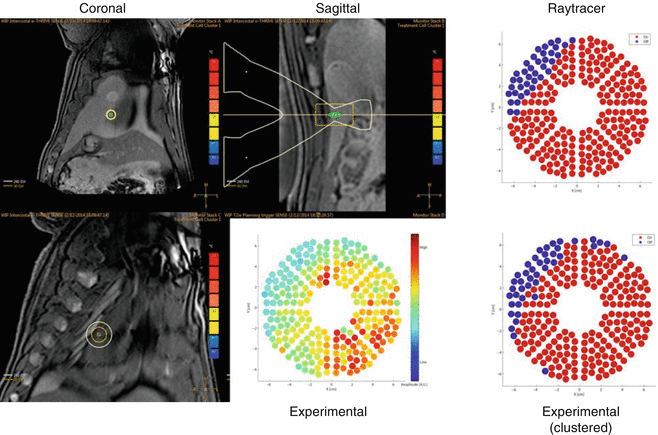

Fig. 3.3
Automatic detection of beam obstruction by the thoracic cage during liver ablation in an in-vivo experiment. The focus is placed in segment 4 of a porcine liver, as shown in the coronal (top left) and the sagittal (top center) T 1 weighted image. As indicated in the coronal image on the level of the sternum (bottom left), the beam cone intersects with parts of the costal cartilage. In this example, the binarized apodization based on geometric ray-tracing (top right) is based on a semi-automatic segmentation of a 3D T 1–weighted MRI of the costal cartilage, resulting in a selective deactivation of obstructed transducer elements. The binarized apodization based on cavitation enhanced back projection (bottom right) leads to comparable results, but requires only a fraction of the acquisition and processing time (<1 s vs. 5.3 min). In addition, this approach provides an estimate of the relative attenuation between focus and transducer for each element (bottom middle) (Image courtesy of Pascal Ramaekers, UMC Utrecht)
As a result, a comparison of the DORT method in simulated experiments with other approaches (binarized apodization based on geometric ray- tracing, phase conjugation and constrained optimization as previously proposed (Gélat et al. 2012) (see below)), indicated that although the DORT method results in an apodization which spares the thoracic cage from undesired acoustic intensity, this is more at the expense of the focal point pressure. In summary, although the DORT approach is conceptually very promising, in–vivo studies that validate the efficiency of the approach are to date still pending.
3.2.2.1 Pulse-Echo Detection
A much simpler approach was suggested by Marquet and colleagues (2011) that exploits the A-mode imaging capabilities of the HIFU transducer directly in order to detect obstructed parts of the transducer. Similar to DORT, this approach exploits the strong backscattering of an emitted acoustic pulse from the thoracic cage. Here, the transducer channels are ordered according to the amplitude strength of their back reflected signal and clustered into obstructed and unobstructed elements. This approach has the advantage to be both very fast and comparably simple, thus having the potential to be compatible with a clinical workflow. The main drawbacks are that although cortical bone represents a strong acoustic reflector, cartilage signal reflection is much harder to differentiate from reflections from the adipose-muscle and muscle-liver/kidney tissue boundaries. This is further complicated by the fact that most HIFU transducers are designed as narrow-band systems at lower frequencies (0.75–1.5 MHz), thus being limited in their A-mode imaging quality.
3.2.2.2 Cavitation-Enhanced Back-Projection
The original implementation of the phase conjugation approach requires a point source in the focus, which emits a spherical acoustic wave that is subsequently received by all transducer elements. As Tanter et al. (2001) have shown, the time-reversal of this received amplitude/phase vector represents a spatially and temporally matched filter of the propagation operator through the heterogeneous medium. The drawback of this approach is that it is invasive, and thus for clinical applications unfeasible. The aim of subsequent work for intercostal HIFU with a transducer apodization based on time-reversal was aimed to circumvent this limitation: Aubry et al. (2008) virtualized the physical time-reversal measurement with model based solutions (see Sect. 3.2.1), while Cochard and coworkers (2009) recorded the complementary information, i.e. the backscatter from the ribs.
The key idea of cavitation-enhanced back-projection is to replace the time-reversal experiment (i.e., using the propagation of a spherical wave from the focus to the transducer in order to derive the transmit apodization of the transducer) with a true pulse echo experiment between the transducer and a point scatterer in the focus. However, this requires placing a sufficiently large point scatterer in the focus of the transducer in a non-invasive way. This is achieved by emitting a first short pulse of ultrasonic energy through all transducer elements simultaneously, which are used to create a sufficient peak negative pressure in the focus to induce non-inertial cavitation. The resulting bubble cloud in the focal area represents a spatially confined cloud of point scatterer. As a result, consecutive ultrasonic waves are then reflected by the cavitation bubbles back onto the transducer.
The relative signal strength received from the back-reflected wave by each transducer element represents a measurement of the relative attenuation between the focus and each individual transducer element. In order to suppress undesired echoes other than those originating from the cavitation bubble cloud, a pulse inversion sequence was used. Using such a sequence, the majority of the received signal originates from the reflections of the cavitation bubbles.
This proposed method allows rapid mapping of any aberrating structures in each of the individual beam paths of the transducer elements before a HIFU sonication is started, and consecutively calculates the appropriate apodization law. Similar to the invasive phase conjugation method, this approach takes both absorbing and scatterering structures in the beam into account, whereby the acquisition and processing times are comparable with the DORT approach (<1 s), and thus entirely compatible with the clinical workflow.
The principal disadvantage of cavitation-enhanced back-projection is the requirement to induce stable cavitation. Stable cavitation requires, in particular in deeper tissue layers, transducer and generator systems, which can deliver large peak acoustic pressures. While this increases the complexity and the cost of the HIFU system, it also increases the risks of adverse effects. Power control of non-linear energy deposition is challenging and pulses in the 3–6.5 MPa pressure regime also increases the probability of potentially harmful inertial cavitation events, which in turn can lead to undesired tissue damage (Hwang et al. 2006; Miller 2007).
3.3 Challenges Associated with Physiological Motion of the Liver and Kidney
Besides the necessity to deposit the acoustic energy across the thoracic cage, the second major challenge for non-invasive HIFU therapy in liver and kidney, with respect to both energy delivery and therapy guidance, is physiological motion. It is therefore important to differentiate between the sources and the time-scale of the different types of physiological motion and the adequate measures in more details:
Respiratory motion
The liver and the kidney of an adult patient move under free-breathing conditions with a periodicity of around 3–5 s, and a motion amplitude of 10–20 mm, as shown in Fig. 3.4. While the motion pattern of free-breathing patients is over longer episodes (<30–45 s) periodic, it is frequently subject to changes in amplitude, phase and frequency before a new stable breathing rhythm is reached. In particular, the occurrence of involuntary spontaneous motion events, such as swallowing, coughing or muscle spasms, is hard to predict and interrupts a regular breathing pattern.
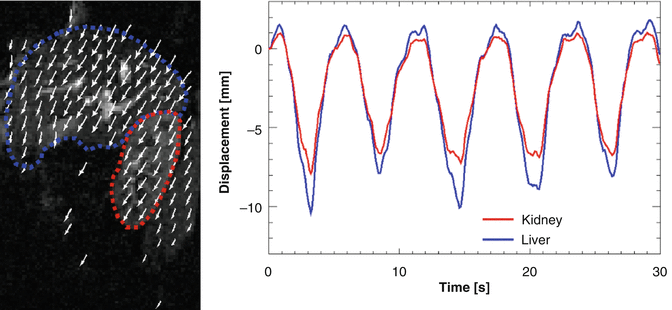

Fig. 3.4
Proof of concept of the motion estimation process performed on-line in the abdomen of a healthy volunteer for liver (inside blue contour) and kidney (inside red contour). The estimation of organ motion is performed using real-time optical-flow algorithm as described in (Denis de Senneville et al. 2011) with the sagittal anatomical images reported on the left. The vertical component of the estimated motion is reported on the right in the liver and the kidney (Image courtesy of Baudouin Denis de Senneville, CNRS/UMC Utrecht)
As a consequence, there is a growing trend to perform non- and minimally invasive therapy under deep sedation. Deep sedation is induced by an intravenous infusion of a hypnotic/amnestic agent, such as propofol or sodium thiopental, to reduce the probability of involuntary spontaneous motion events.
The additional use of analgesic drugs, in particular analgesics based on opioids, lead to respiratory depression, sometimes used to reduce in addition both the respiratory frequency and amplitude. Although the patient still displays spontaneous respiration, this measure can significantly increase the time fraction during which the abdomen is not subject to respiratory motion.
The next step from this intermediate regime is to induce complete respiratory depression and to control the respiratory cycle by an external mechanical ventilator. This approach leads to repetitive and stable respiratory motion over long durations, whereby the amplitude and the frequency can be adjusted within the boundaries of sufficient blood-oxygen saturation according to the required interventional workflow.
Peristaltic motion
A second important source of physiological motion is induced by peristaltic and digestive activity in the digestive tract. Although the time-scale of peristaltic motion events depends on the particular source, such as bladder filling with urine, the development of digestive gases or the passage of digestive products in the gastrointestinal tract, the resulting abdominal organ position shifts usually occur on a scale of several minutes (Mirabell et al. 1998; Langen et al. 2008). Although peristaltic motion is with respect to both amplitude and speed a magnitude below respiratory induced displacements, it is generally non-reversible and a-periodic. Peristaltic motion can clinically be moderated by several measures: Peristaltic bowel motion and the development of peristaltic gases can be reduced by adjusting the diet of the patient prior to the intervention (Smitmans et al. 2008). Similarly, administration of Butylscopolamine, which represents a peripherally acting antimuscarinic and anticholinergic agent used as an abdominal-specific antispasmodic (Emmott et al. 2008). Furthermore, shifts in the lower abdomen due to bladder filling can be reduced by the use of Foley catheters (Mirabell et al. 1998).
Spontaneous motion
Finally, spontaneous motion is considered one of the most challenging types of physiological motion since it occurs infrequently, on a very short time-scale and is in general irreversible. It is particularly problematic for long interventions that require the patient to remain in an uncomfortable position. In the past, this problem has been alleviated in the field of external beam therapy by using either restraints, such as molds or casts (Verhey 1995), by sedating the patient (Zhang et al. 2010), or by introducing general anesthesia (GA).
3.3.1 Motion Compensation Strategies for HIFU Ablation on Abdominal Organs
As shown in Fig. 3.5 the typical workflow of an MRI-guided HIFU intervention starts with an initial planning (5–15 min), followed with a sequential set of energy depositions (5–60 s each) together with the associated cool down delay (30–180 s, depending on the energy density in the near-field).
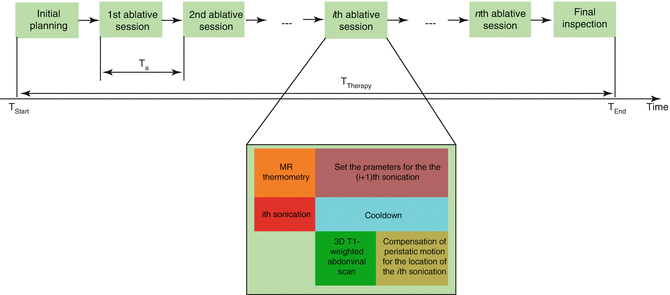

Fig. 3.5
Typical workflow of an MR-guided HIFU intervention. During the initial planning a set of anatomical images is obtained on which the planning target volume (PTV) around the tumor is delineated. In general, the PTV is ablated in smaller subvolumes, which allows intermediate tissue layers to cool down during the intervention. At the end of the intervention a dynamic contrast enhanced 3D MRI validates the therapeutic endpoint (Image courtesy of Cornel Zachiu, UMC Utrecht)
This therapeutic phase can have duration of up to 3 h. It is concluded with a set of physiological and functional MRI datasets, which validate the therapeutic endpoint. As Fig 3.5 displays, while peristaltic motion is during the short duration of each of these episodes not a major problem, these shifts can become challenging when considered at the time scale of the entire intervention.
The influence of respiratory motion during the initial and the final phases of the intervention are generally addressed with the established measures of diagnostic MRI: Either respiratory gating or breath holding. During the therapeutic phase, both for MR-guidance and energy delivery, respiratory induced motion needs to be addressed individually. Several approaches have been investigated to achieve this:
Induced Apneas
The most simple and efficient way to prevent undesired respiratory motion of abdominal organs is to temporary interrupt the respiratory cycle. This is generally achieved by inducing general anesthesia with hypnotic/amnestic agents, which are given in conjunction with analgesics based on opioids to achieve a full respiratory depression. This allows controlling the respiratory cycle entirely by mechanical ventilation, which in turn can be synchronized with the therapeutic energy delivery. Several clinical studies have demonstrated the feasibility of this approach: Both Gedroyc (2006) and Kopelman et al. (2006) have successfully ablated Hepatic tumors by repetitive induced apneas. The main advantage of energy delivery during induced apneas is that this approach is compatible with any type of clinical HIFU equipment and does not require major modifications with respect to beam steering capabilities or beam amplitude modulation capabilities. The main drawback of this approach is that it reduces the non-invasive nature of MR-guided focused ultrasound interventions. While for primary tumor therapy of patients with a good general condition, an intervention under sustained general anesthesia of 2–3 h is generally considered clinically acceptable, the situation is more complicated when metastatic disease or patients in a poor general state are considered. In particular, for the case of metastatic disease, where local HIFU therapy represents only one aspect out of a combination of systemic and local therapy measures, an increased invasiveness of HIFU therapy is likely to reduce both the therapeutic possibilities and patient eligibility.
Stay updated, free articles. Join our Telegram channel

Full access? Get Clinical Tree



